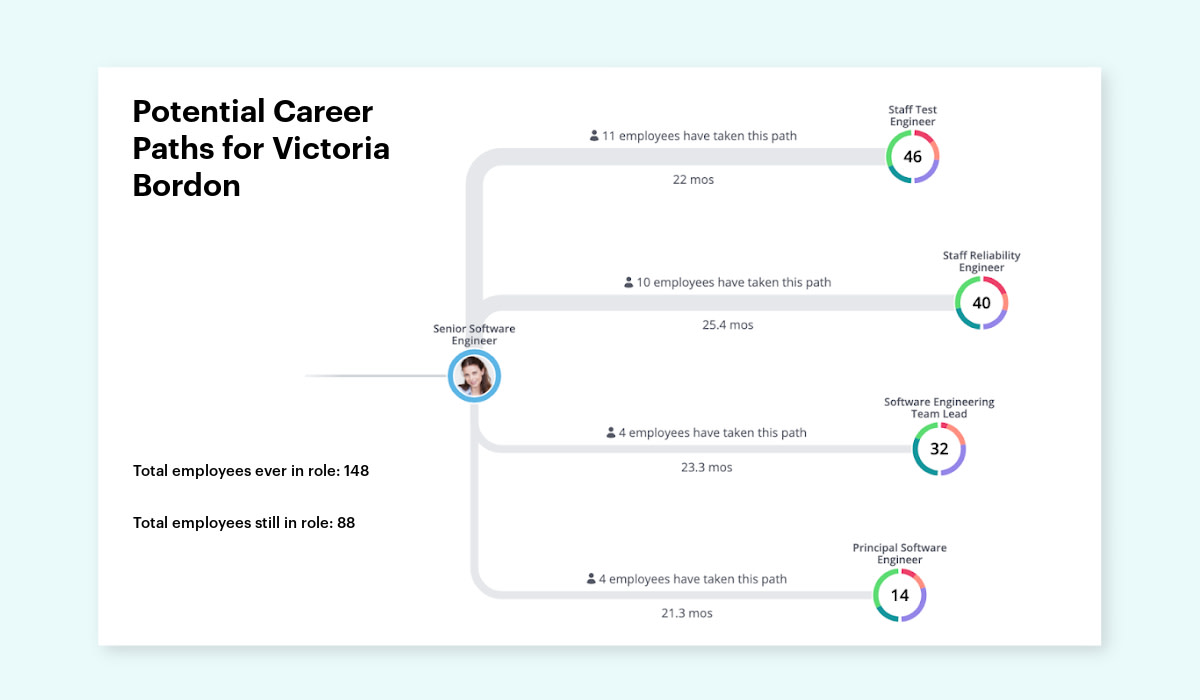The Future of Management Depends on Access to People Data
Visier and Deloitte on the future of management, and why access to people data is crucial to business decision making.

“Why is our revenue down and our costs up?” The C-suite executives call out from one side of a canyon. On the other side is a goldmine of people data that could address, even solve, these critical business issues. Connecting these two sides is imperative to a sustainable and successful future of management.
This chasm is what Visier’s VP of People Analytics, Ian Cook has coined the “People Impact Gap.” It’s where managers cannot access the answers they need about their people in order to make better business decisions.
The future of management is in the people answers
The gap is the focus of a new research collaboration between Deloitte and Visier, and closing it is a crucial investment imperative for CHRO’s and executive leaders, says Cook, one of the report’s co-authors. A recent Deloitte survey of 500 business leaders revealed their low confidence in addressing some of the most pervasive, everyday business and people topics. Having access to swift answers is one surefire way to level up confidence.
So, what’s the best way to span between the answers that managers need and the raw data that exists within the systems? Communication—and it’s not only what is said. “Data is its own language,” says Cook. “And learning how to analyze it for better decision making is a game-changer for people leaders.”

Closing the gap relies on widening access to insights
In the past, mining crucial people insights meant weeks or months of slow, manual research. Today, we know that “people are the business,” as Cook quips. And the urgency to understand them has been increasing in importance—something this crucial to a successful future of management can’t wait weeks or months.
“It’s really challenging if a business executive comes to a people analytics team and says, ‘I’ve got an urgent business problem,’ and the team must spend time trying to determine where to wrangle all the data from, and how to organize it in a way that would produce important insight to deliver back to the business.” Says Marc Solow, leader of Deloitte’s Human Capital Analytics and Insights Solutions. Without the right talent and the right technology staged and ready to tap for insights, providing answers accurately and quickly is impossible.

The People Impact Gap is the chasm between the crucial answers that people managers need and the raw data that is contained within the people systems of record
Step 1: Go beyond HR
The first step in narrowing the gap is getting past the idea that people data belongs entirely to HR. Historically, HR applied people data to optimize HR functions, which is a worthy use, yes, but there’s so much more it can impact in the future of management. People data can be applied to meet the needs of the business, as well, and getting this data from HR into the hands of business leaders closes the People Impact Gap.
“There is a tremendous amount of demand across the market for HR organizations to do more with the people data that they have in their HR solutions,” says Solow. “To use that data to answer fundamental questions like: ‘Have we optimized our investment in the workforce?’”
How can CHROs and executive leaders enable people managers to make better decisions, and ones that scale up to affect an organization’s success? By giving them access to data insights. “I do believe that people data is going to be an essential element of success in the future of management and in HR functions,” comments Solow. It’s the foundation for solving critical people issues that have a huge impact on the business—issues like retention, or hiring quality talent in a tough market.
Access to people insights such as who are your highest performers or who is at risk of burnout helps reveal those employees who may benefit from a promotion, or who may be interested in another opportunity within the company. Internal hiring, after all, is a clever TA strategy in a competitive talent market.
Step 2: Applying insights to issues
We can’t always know what the future holds, but we can make educated decisions—especially when they’re informed by data. It’s the goal of mature people analytics teams to, as Solow explains, “take data, translate that data into insights, and then take those insights to stimulate thinking around actions to take in order to improve their business across the dimensions of work, workforce, and workplace.”
Armed with historical insights and the right HR metrics like compensation levels, retention rate by compensation level, and how pay rates have changed over time, a skilled people leader can confidently plan and execute an effective compensation strategy for her team. That strategy can end up impacting the entire organization.

Providence, a major healthcare system with 120,000 employees and 50 hospitals, is a great example of using historical data trends to solve current problems like turnover. To determine if paying certain employees more could positively impact the business, they looked at retention trends of past groups of new hires within a certain time frame. For those who exited, the People Analytics team examined what their pay had been in relation to the compensation-rate midpoint for the role. This revealed the demonstrable true cost of paying employees below the midpoint range for their role, and enabled HR to identify where the organization would at least break even—if not make the business money—by paying certain employees more to stay.
The future of management is analyzing patterns of data from different people systems, building an understanding of the true picture of how work gets done, and enabling realistic expectation-setting in order to reach organizational goals.
Reveal operational obstacles, clear the way for progress
Reaching business-wide goals, of course, involves people working in harmony to align and execute. Finding where that harmony is going off-key—or has fallen into the gap—prevents progress towards successful business outcomes. Relying on a hunch won’t cut it in the future of management, instead analyzing and acting on people insights to locate issues that can be fixed is the smartest way to realign people and processes.
First West Credit Union used people analytics to identify obstacles and streamline their recruitment process, generating millions of dollars in savings for the organization. The HR team found inconsistencies in workforce process and data coding. Acting on these insights, they created standard protocols for pre-screening, assessing, and handling pools of candidates—both external and internal to the organization.

Understanding the potential career path of an employee, and acting on that insight, can impact an entire organization.
In the figure above, a software engineer’s career path depends on her direct supervisor’s ability to access and synthesize these insights. There are a number of ways the engineer could go within the organization, and each path has an impact on the employee, the team, the department, and the business.
An employee’s career path is a potential people answer to a business problem.
Integrating people analytics into the business does more than speed up ordinary HR processes; it enables decision making from a business-first view so that when people make assessments about where to put their technology money, they’re putting it in a place that will have the maximum impact on the business—not simply to drive efficiency into what they already have. Yes, our engineer could benefit personally from an optimal career path—financially, professionally—but span the People Impact Gap and find where her career path can also benefit the business. That’s the future of management.
Committing to a data-informed future
To successfully navigate work and leadership in the future, to really ensure that the rubber meets the road, the people answers meet the people leaders, the People Impact Gap must narrow significantly. “We’re already in the throes of this great work experiment where how people work, where people work, and choices that people have have all been thrown up in the air,” explains Cook. “Making good, equitable decisions that align people to the work that fits them best requires more than the intuition of a manager.” It requires a commitment to data-driven decision making.
The future of management is augmented with data. Data doesn’t replace managers, but in the same way that athletic performance is augmented by training and competition data, so too will people managers and their teams be made better, faster, stronger with access to insights. Working towards this data-informed future elevates everyone’s game.
Want to learn more? Read the full report: The Future of People Management: Closing the People Impact Gap for Better Business Outcomes
Get Outsmart content straight to your inbox
Subscribe to the People Insights Monthly newsletter for actionable insights and stories.
Subscribe now